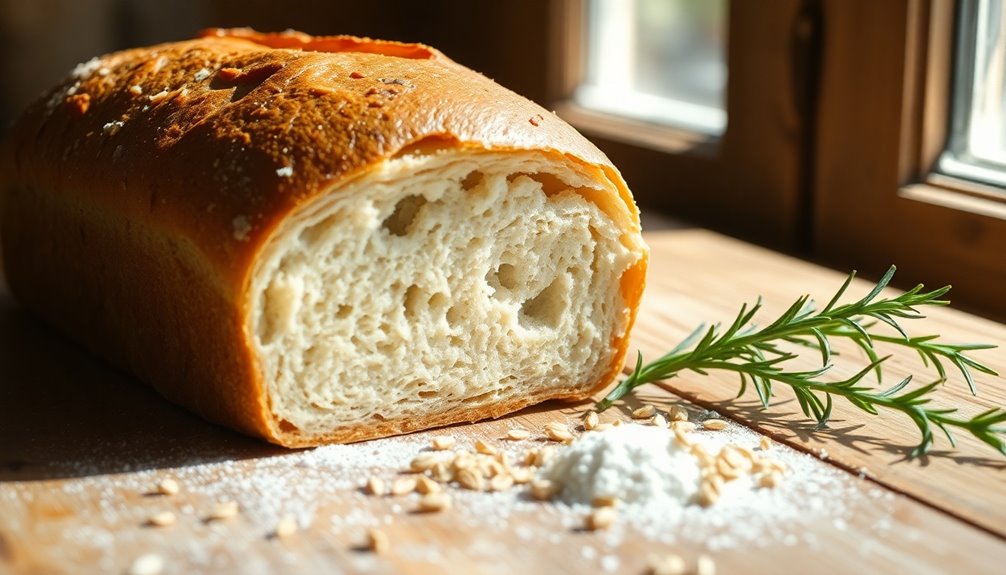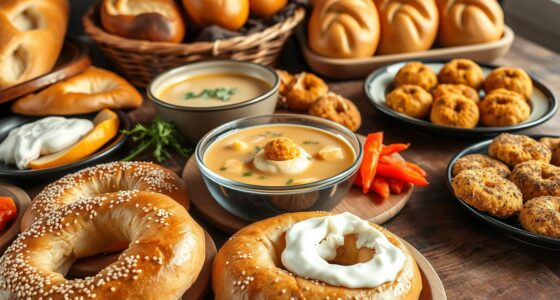Darnitsky Bread is a traditional rye bread from the Darnitsa district of Kyiv, beloved for its sourdough flavor and dense texture. It plays a significant role in Russian culture, symbolizing hospitality during family gatherings. To prepare it, you'll create a preferment with rye flour, water, and sourdough starter, allowing it to ferment overnight. Then, you mix, knead, shape, and bake the dough to achieve a crusty finish. Explore more about its history and preparation tips to master this culinary treasure.
History
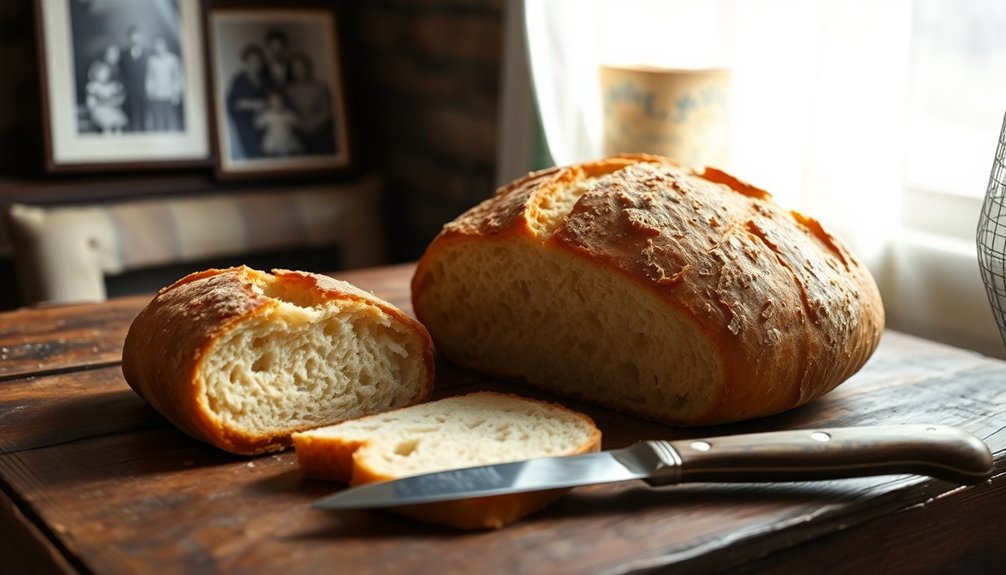
Darnitskiy bread has a rich history that intertwines with the cultural fabric of Russia. This traditional rye bread, known for its distinct sourdough flavor, has been a staple in Russian households for centuries.
Originating from the Darnitsa district of Kyiv, Ukraine, it reflects the agricultural practices of the region through its locally sourced ingredients. You'll notice its dense texture and impressive shelf life, making it perfect for sandwiches or preservation.
Darnitskiy bread isn't just food; it's woven into cultural rituals and family gatherings, symbolizing hospitality and cherished homemade traditions.
When you break bread with family or friends, you're partaking in a legacy that celebrates togetherness and the essence of Russian culinary heritage.
Recipe
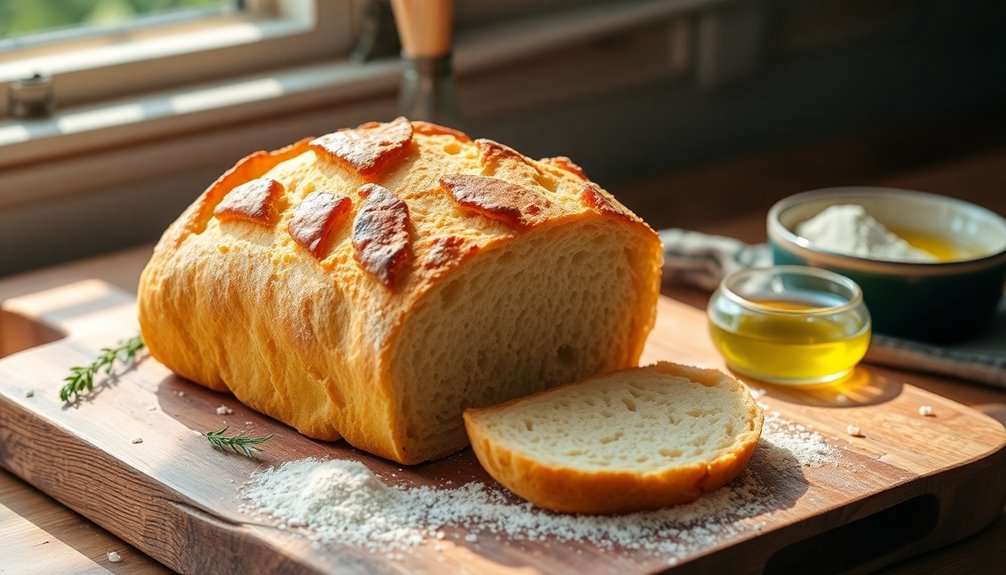
To begin, you'll need to prepare a preferment the night before baking. This step is crucial as it allows the flavors to develop fully. By mixing whole rye flour, water, and sourdough starter, you create a base that contributes to the bread's distinctive characteristics. The fermentation process takes about 10-12 hours, so plan accordingly to achieve the best results.
Prepare a preferment the night before to enhance your Darnitskiy bread's flavor and texture through proper fermentation.
Ingredients
- 400 grams whole rye flour
- 400 grams water
- 120 grams sourdough starter
- 100 grams fermented red rye malt
- Additional whole rye flour (up to 200 grams, optional)
- Regular flour (reduced to accommodate rye flour adjustment)
- Boiling water (for steaming and malt preparation)
Cooking Instructions
In a large mixing bowl, combine the prepared preferment, 100 grams of fermented red rye malt mixed with boiling water, and any additional whole rye flour as needed to adjust the texture.
Mix gently with wet hands to incorporate all ingredients without overworking the dough, which can lead to flat bread.
Once combined, shape the dough into a loaf, then place it on a parchment-lined baking tray. Allow the dough to rest for about 30 minutes before baking.
Preheat your oven to 230°C (450°F) and create steam by placing a tray of boiling water in the oven.
Bake the bread for 10 minutes, then lower the temperature to 200°C (400°F) for an additional 40 minutes or until the bread sounds hollow when tapped.
Extra Tips
When making Darnitskiy bread, it's essential to keep your hands wet during the mixing and shaping process to prevent the dough from sticking.
Additionally, be patient with the preferment—allowing it to ferment for the full 10-12 hours will enhance the flavor significantly.
If you want to experiment with flavors, consider adding seeds or herbs to the dough before baking.
Lastly, the steaming process is crucial for achieving a crispy crust, so ensure that your oven is adequately preheated and the steam is created effectively.
Enjoy your freshly baked Darnitskiy bread with your favorite spreads or alongside hearty soups and stews!
Cooking Steps
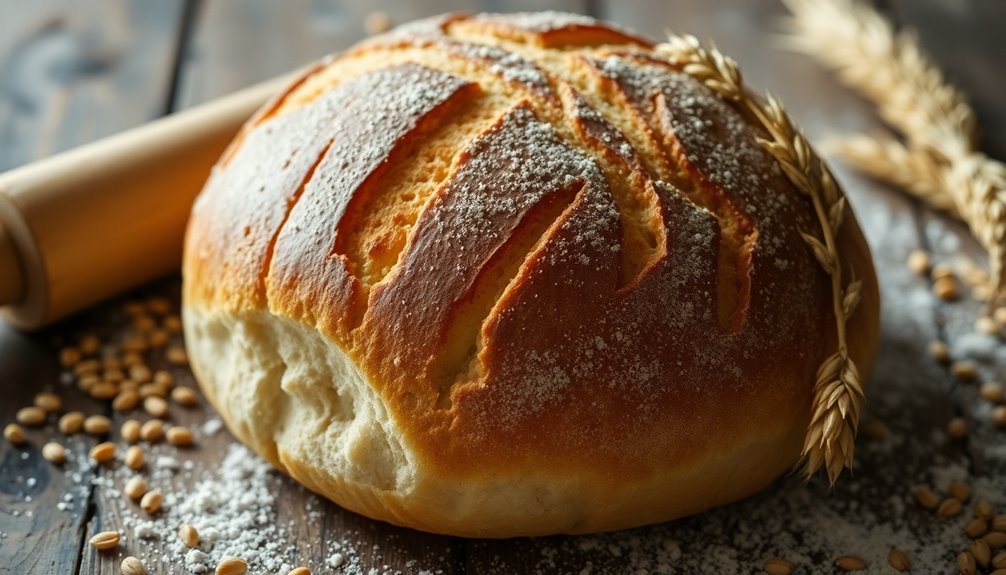
To get started on your Darnitsky bread, you'll want to prepare all your ingredients for the dough.
Once everything's ready, knead the dough thoroughly to ensure a good texture.
After that, let it rise completely before shaping it into loaves for baking.
Step 1. Prepare Ingredients for Dough
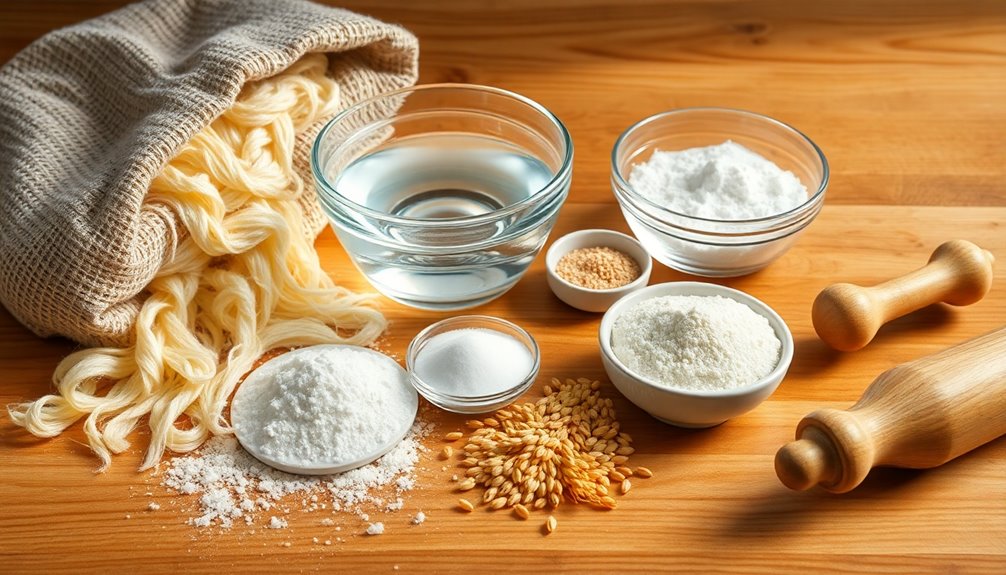
Start by mixing 400 grams of whole rye flour, 400 grams of water, and 120 grams of sourdough starter to create a preferment.
Let it rise for 10-12 hours until it bubbles and develops flavor.
Next, steep 100 grams of fermented red rye malt in 500 grams of boiling water, stirring well to prevent clumps.
Once your preferment is ready, combine it with 20 grams of salt, 20 grams of oil, the steeped red rye malt, 400 grams of light rye flour, and 400 grams of all-purpose flour.
Handle the dough gently with wet hands to maintain its structure.
Cover the mixture and let it rest for 30 minutes before proceeding to proofing.
Step 2. Knead the Dough Thoroughly
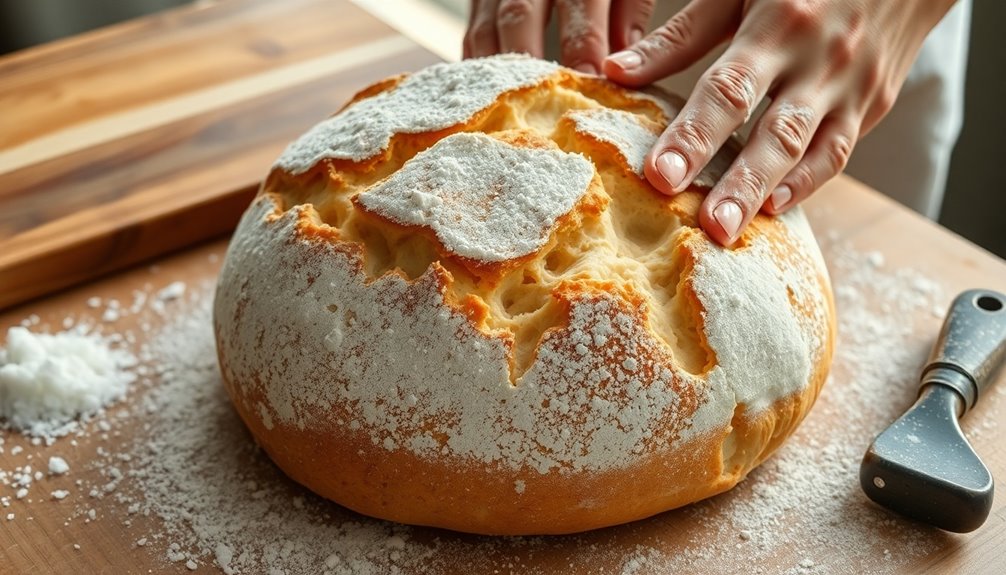
After letting the dough rest, it's time to knead it thoroughly.
Use wet hands to gently press down and fold the dough, ensuring you don't flatten it. This method helps maintain its airiness while incorporating the rye malt evenly.
Knead for about 5-10 minutes, focusing on achieving a smooth, elastic texture without overworking it. If the dough feels too wet, resist the urge to add flour; instead, keep kneading to help it absorb the moisture.
The goal is to create dough that holds its shape and feels slightly tacky to the touch. Once you achieve this consistency, you'll know it's ready for the proofing stage.
It's a crucial step in making perfect Darnitsky bread!
Step 3. Let Dough Rise Completely
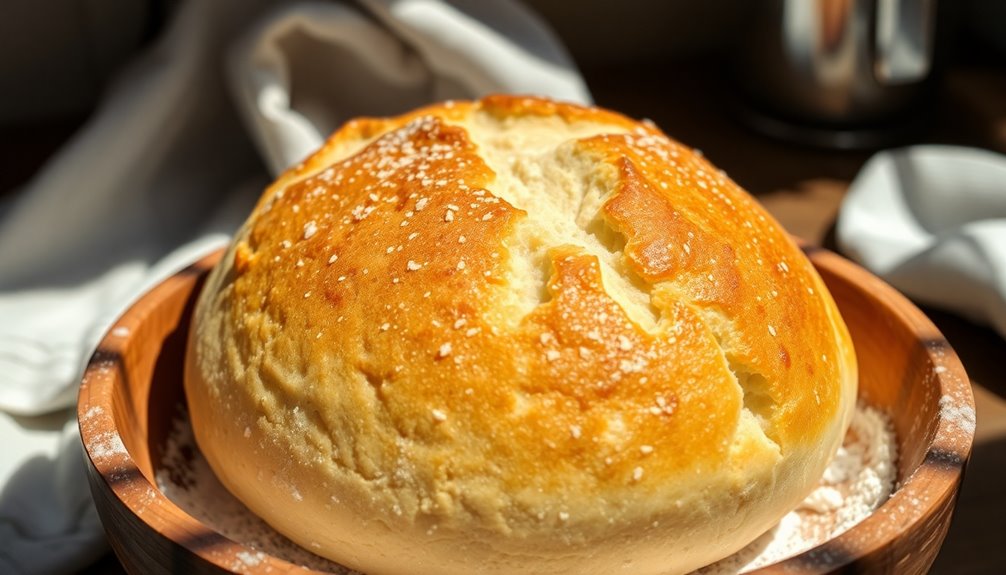
Allowing the dough to rise completely is essential for developing its flavor and texture. After mixing your dough, cover it to prevent crust formation and let it rest for 30 minutes. This enhances the texture before proofing.
For proofing, split the dough into halves and smooth it out. Cover each piece with plastic wrap, and let them rise at room temperature for 1-2 hours until they double in size. Remember to handle the dough gently with wet hands to maintain its structure.
As you wait, preheat your baking area to 230°C (450°F). Using a coated bread pan with oil will help prevent sticking and ensure a well-shaped loaf, crucial for your bread recipe.
Step 4. Shape the Dough Into Loaves
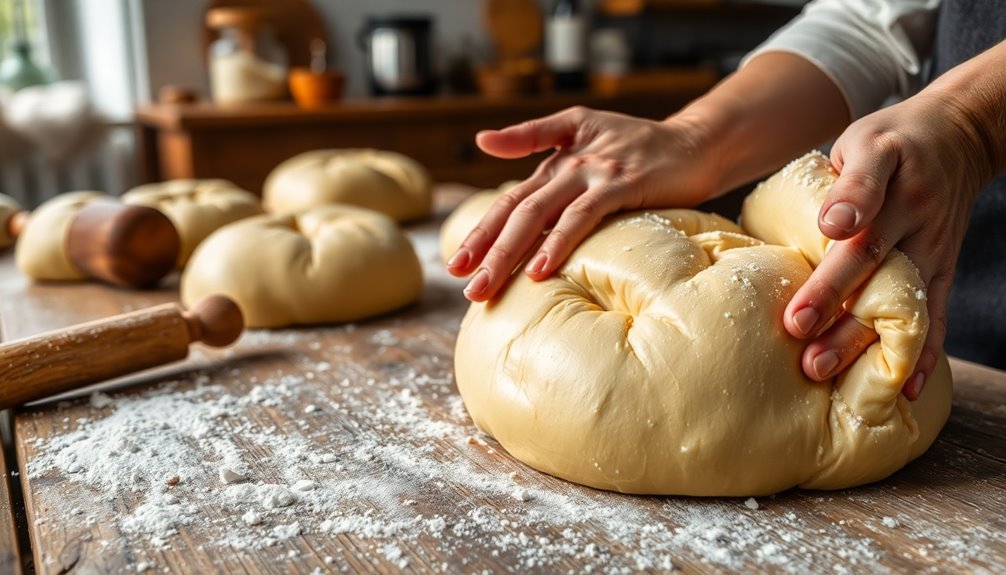
With the dough fully risen and ready, it's time to shape it into loaves. Gently fold the dough from all sides and split it evenly in half.
Using wet hands, smooth out each piece to prevent sticking and ensure a uniform shape. Next, place the shaped dough into a greased bread pan, making sure it fits comfortably without crowding.
Cover the shaped dough with plastic wrap to keep it from forming a crust and let it proof until it doubles in size, which usually takes 1-2 hours at room temperature.
Before baking, smooth the dough gently again with wet hands to maintain its shape and texture. Now, you're all set for the next steps!
Step 5. Preheat the Oven Properly
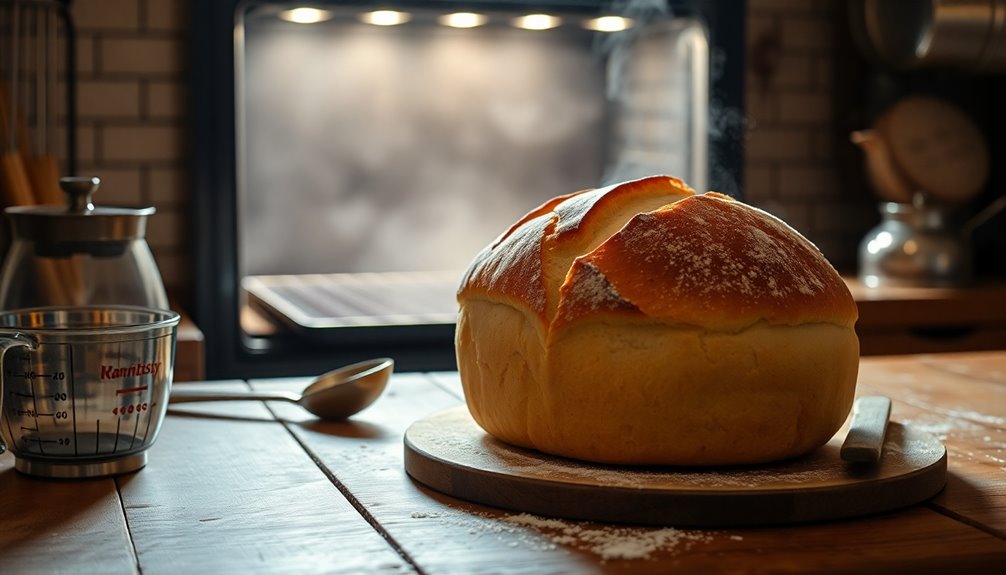
To ensure your Darnitsky bread bakes perfectly, you need to preheat the oven to 230°C (450°F) for at least 30 minutes before the dough is ready. This step is crucial for achieving even baking and a nice crust.
While the oven heats, place a tray on the lower rack; you'll use it to add boiling water later. Steam is vital in the first 10 minutes of baking, helping create that perfect crust.
After those initial minutes, reduce the temperature to 200°C (400°F) for the remaining 40 minutes. Consistent preheating prevents temperature fluctuations, which can mess with the rise and texture of your Darnitsky bread.
Get this right, and you'll enjoy beautifully baked loaves!
Final Thoughts
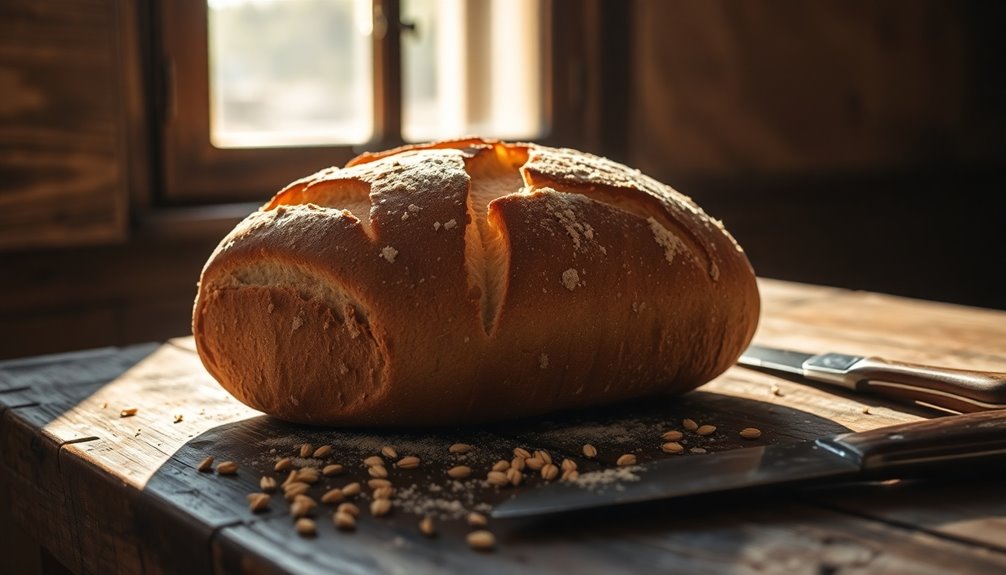
As you explore the world of Darnitskiy bread, you'll discover a delightful blend of tradition and versatility that makes it a standout choice for any meal.
This bread's unique sourdough rye flavor lends itself perfectly to morning sandwiches while allowing for flexibility in your recipe. You can easily tweak the ingredient ratios, perhaps opting for more rye flour or even using all-purpose flour when needed.
Remember, the preferment process is key to achieving that rich flavor and texture. With proper handling and proofing, you'll avoid flat loaves.
Plus, you can store Darnitskiy bread in the freezer, ensuring you always have a delicious option on hand. Embrace this traditional bread and enjoy its many possibilities in your kitchen!
Frequently Asked Questions
Why Is Russian Bread so Good?
You might wonder why Russian bread stands out, and it's no coincidence. Its unique flavors come from whole grains and natural fermentation processes.
This bread's dense texture and robust taste are a result of traditional methods that prioritize quality over quantity. Plus, the minimal ingredients enhance its nutritional value.
When you savor a slice, you're not just tasting bread; you're experiencing a rich cultural tradition that celebrates authenticity and craftsmanship in every bite.
What Is the Most Popular Bread in Russia?
The most popular bread in Russia is Borodinsky bread.
You'll love its dark color and rich flavor, which come from rye flour and caraway seeds. This bread's unique taste makes it a staple in many households.
You might find it served with meals or enjoyed on its own.
With traditional sourdough fermentation techniques, Borodinsky not only tantalizes your taste buds but also embodies the heart of Russian baking culture.
What Happened to Claussen's Bread?
Claussen's bread was once a beloved rye bread, renowned for its distinct sourdough flavor and dense texture.
However, it faced stiff competition in the bread market, leading to its discontinuation in the early 2000s.
While you might remember its unique taste, the brand struggled to maintain its loyal customer base.
Despite its absence, many fans still cherish the memories and continue to seek ways to recreate that iconic Claussen's experience at home.
Is Borodinsky Bread Healthy?
Imagine sinking your teeth into a slice of hearty, aromatic rye bread.
Borodinsky bread is indeed healthy! Packed with fiber from whole grain rye, it aids digestion and supports heart health.
Those caraway seeds? They're little nuggets of antioxidants. Plus, it's lower in calories than white bread, helping you feel full while managing weight.
Its natural fermentation adds probiotics, making it a delicious choice for gut health.
You'll love how satisfying it is!
